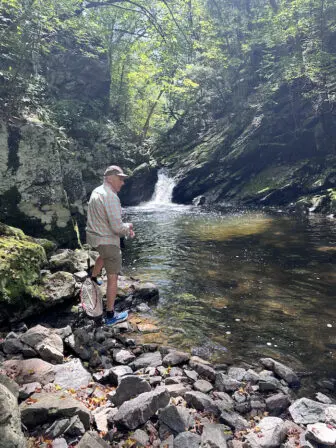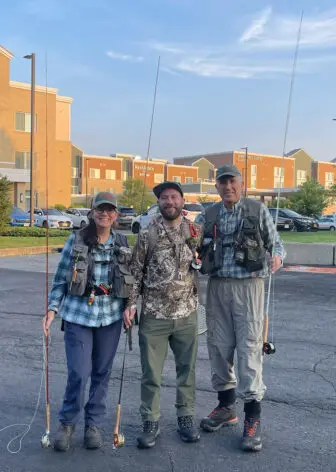But how much longer can they survive?
After many months of searching, my quest to find the legendary wild brown trout of Clove Creek was starting to feel like hunting for Sasquatch.
One morning last month, I cast a shiny lure into a crystal clear pool in Clove Creek off Route 9 in Philipstown near the Putnam County line. It was my third cast in a tiny stretch of water that looked, as we anglers like to say, “fishy as hell.”
When I felt a tug, I muttered, “Please be a trout.”
In 50 years of fishing, I’ve landed hundreds of trout. But the 6-incher on my line that morning was my first catch in Clove Creek. And it was the culmination of six trips to find brown trout in the waterway.
More important, it was confirmation that the Clove Creek brown trout have so far managed to survive the one-two punch of development and global warming that has devastated so much habitat.
They’ve done so thanks to fortunate geology. Clove Creek flows through a 100-yard canyon where shade and groundwater create a cold-water refuge for the fish, which need mid-60s temperatures to thrive. When temperatures drop in the fall, the fish spread out.
“A stream that has that kind of refuge has a shot at persisting as a trout stream,” said Fred Henson, the coldwater fisheries unit leader for the state Department of Environmental Conservation.

Finding the Clove Creek trout was tough. Many anglers have told me that large brown trout lurk in the 14-mile stream, which winds from the lake at Glynwood west along Route 301 and north along Route 9 to Fishkill. Unlike Fishkill Creek and Peekskill Hollow Creek, Clove Creek has never been stocked by the DEC.
“There are fish to be had, and they’re big,” insisted Jim Corless, a former Philipstown resident who works at Trout Town Flies in Roscoe. He said that when utility workers stayed in local hotels in 2011 after Hurricane Irene, they dined on trout caught in Clove Creek.
But much can change in a decade, and I had doubts. If it was such a great stream, why did I never see anyone fishing there? Last year, I fished a public stretch along Route 301 and got skunked. The water seemed too warm for trout.
During the summer, much is too warm. When the Hudson Highlands Land Trust commissioned a study in 2019, it found that the water temperature ranged from 69 to 74 degrees. Trout typically get stressed in water above 68 degrees and can die with prolonged exposure to 75 degrees or higher. On a foray to a stretch of the creek behind North Highlands Park near Glassbury Court, I caught sunfish, a warm-water species that rarely coexists with trout.
More experienced anglers than myself also had doubts about Clove Creek. Tim Miller, who has fished in the area since 1989, said he’d never caught a trout in Clove Creek but “maybe there are some old trout living under the bank eking out a living.”

Undaunted, I organized a trip to the northernmost section of the creek with two experienced anglers: William Gipe, a partner at Old Souls, the Cold Spring clothing store and fly fishing outfitter, and Nancy Montgomery, the Putnam County legislator, who grew up fishing. Neither of them had ever caught trout in Clove Creek and this time was no exception. Instead, we were mauled by mosquitoes.
Even though the DEC has long designated the creek as “trout-spawning,” its population seems to be waning. Thirty years ago, the agency did a census of the creek at three sites and found 38 brown trout and three brook trout.
More recently, in 2016, the DEC did another survey and found three brown trout and no brook trout. (A DEC representative cautioned against drawing conclusions based on only two studies using different methodologies, but still…) The 2016 study classified Putnam and Dutchess counties as areas with a “greatly reduced” population of brook trout, which are considered more sensitive to habitat change than brown trout.
The decline of trout habitat in the U.S. is well documented. In 2016, a survey found that, of 28 native trout species and subspecies, three were extinct and six were threatened or endangered. Nine in 10 species faced some level of risk.
How long the Clove Creek browns can hold out is unclear. Henson noted that the recent heavy rains and relatively mild summer have likely been helpful. “In a hot, dry summer, there may be a lot less cold water seeping into that pool,” he said. “So I would avoid fishing it in those circumstances.”


The anglers in search of trout in Clove Creek must not be hitting the good spots. [via Facebook]
Great article, but it’s a bit ironic to spot burn the last of the Highlands trout [by revealing their location]. [via Instagram]
Thanks for the great article from Joey Asher about the trout that are hanging on in Clove Creek. Wonderful news!
Trout are the canaries in the coal mine when it comes to the health of our waterways, and the most significant negative impact to our local trout populations (and waterway ecosystems) is the constant sedimentation of our creeks and streams from dirt roads.
My son and I have been delighted to discover small populations of native brook trout (the state fish of New York) in Phillipse Brook near where we live. Yet each year the deep pools the trout require for habitat get filled in by never-ending sedimentation from Philipse Brook Road and Old Albany Post Road. The same is true to a certain extent for Indian Brook and Indian Brook Road.
My estimate is that at least 50 to 100 tons of Item 4 sediment flow into our creeks each year, which is unsustainable. Many local champions of dirt roads consider themselves to be ecologists but have not considered the ecological impacts of maintaining dirt roads. This decision is choking out the springs and creeks downstream.
If we are serious about protecting our waterways and their ability to hold trout, we have to address the dirt roads. Culverts and drainage needs to be vastly improved, and at the very least strategic sections of dirt road that perennially pollute our waterways must be paved or upgraded with more impervious surfaces. Pave it to save it!